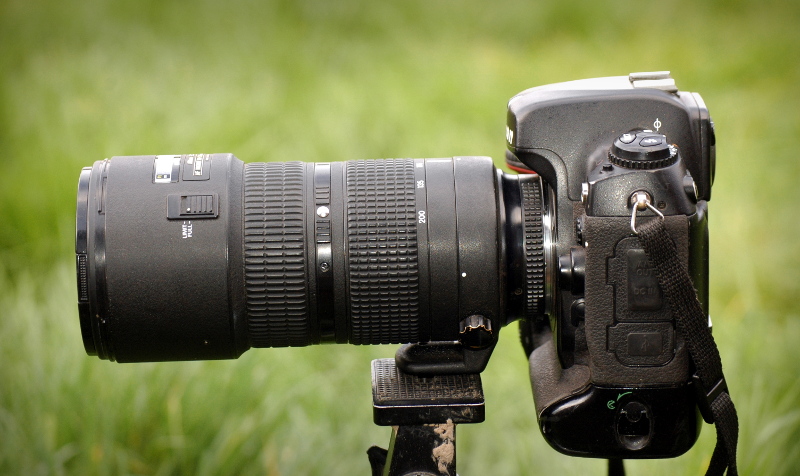
Mounted on a Nikon D2Hs.
from Shutter, by Lewis Collard

Mounted on a Nikon D2Hs.
This is the Nikon 80-200mm f/2.8 D, formally known as the Nikon ED AF Nikkor 80-200mm 1:2.8 D, a superbly-built and optically great lens which is a relative bargain for a f/2.8 telephoto lens.
This lens works fine with all single-digit professional cameras, all full-frame cameras, and some cheaper cameras.
It won't autofocus on many of Nikon's cheapest digital SLR cameras. Here's what I know so far:
It's easy for this list to fall out of date as new cameras are introduced, so if I've missed yours, ask me.
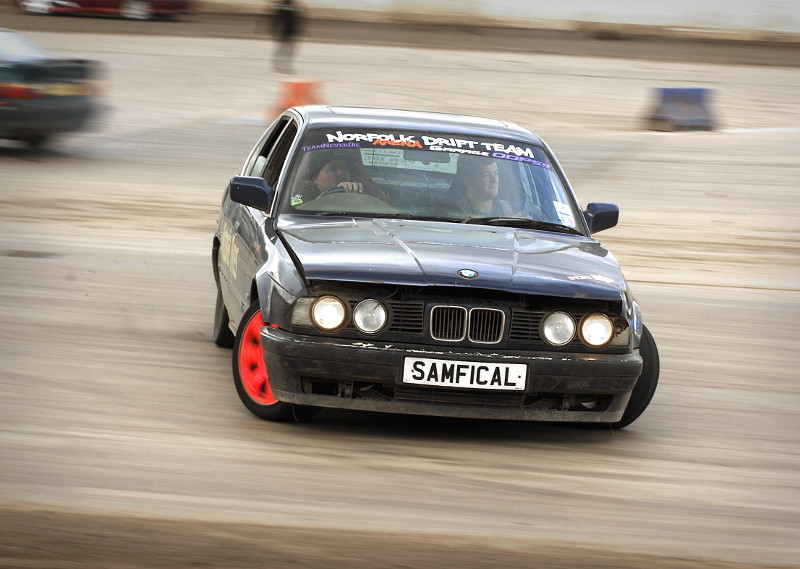
Sam Peate, shot with a
Nikon D2Hs, 80-200mm f/2.8 AF-D at
80mm and f/7.6, 1/100 at ISO 200.
This lens is actually more broadly compatible with film cameras than it is today's SLRs.
It will autofocus and give you all available exposure modes on all of Nikon's autofocus 35mm SLRs, going right back to the F401. As it has an aperture ring, it'll also give you aperture priority mode on the Nikon F4 and the other early autofocus SLRs which had no way of setting the aperture on the camera.
This AF-D lens is also an AI and AI-S lens. Therefore, it should also work perfectly on all film cameras made since about 1977 (including allowing Automatic Multi Pattern metering on the FA). It works great as a manual focus lens, too, because of the lovely, big focus ring.
It gets even more interesting if you start looking at older, pre-AI-era cameras. Take a look at the aperture ring on this lens and you'll notice two dots near the f/5.6 mark:
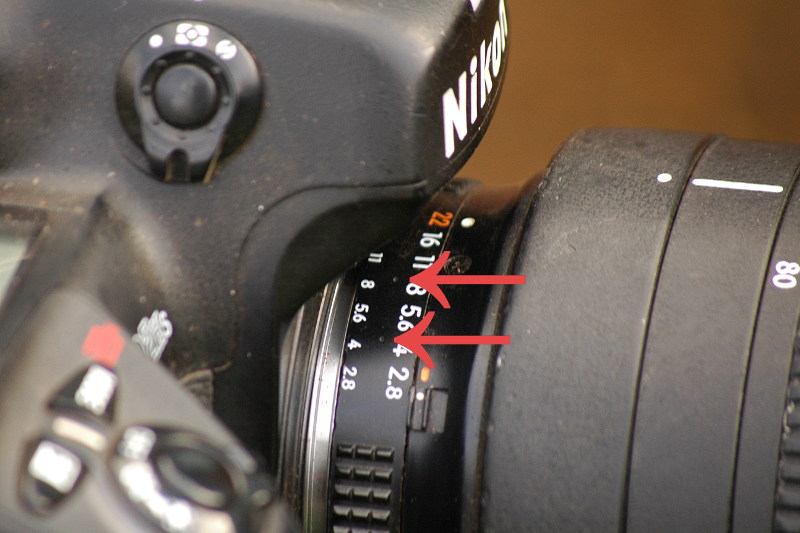
These are pilot holes for attaching a "rabbit ear" meter coupling yoke, so that you can use your lens on even more ancient pre-1977 cameras! John White does this "Type C" conversion for $35, for use on all Nikon F-mount SLRs going back to the Photomic viewfinder for the original Nikon F. Open-aperture metering with a brand new lens on a 1959 SLR! I haven't tried it, but if you start seeing these showing up on eBay with "rabbit ears" attached you can blame me. (Just kidding, you're the only person who has ever read this page and you are lovely.)
The large front housing of this lens has Nikon ED AF Nikkor 80-200mm 1:2.8 D written on it:
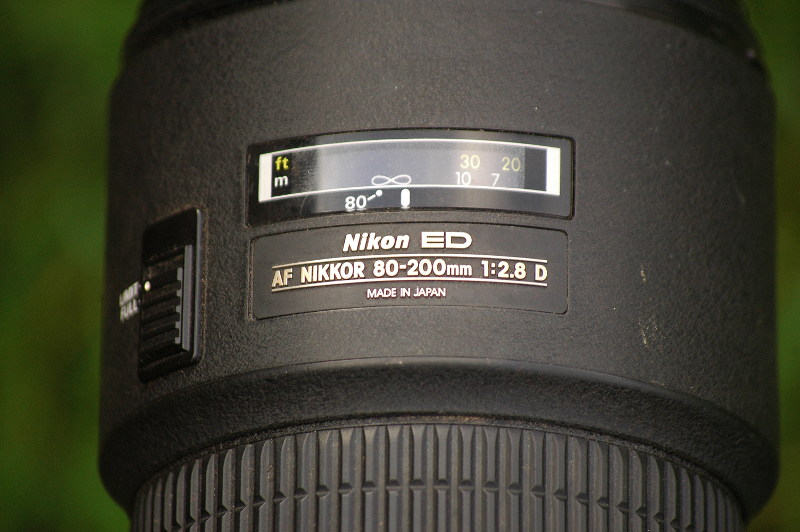
(Sorry if anyone's upset at seeing gear that isn't spotless; this was
after a firm wipe-down after a day at the Norfolk Arena.)
ED means Extra-low Dispersion optics. This was Nikon's name for some magic they did in the early 1980s to make lenses with (at the time) incredible zoom ratios.
AF just means "Auto Focus", as you might have expected.
"Nikkor" is Nikon's brand name for its lenses, used on everything except (as far as I know) its Series E lenses from the early 1980s.
1:2.8 is another way of saying f/2.8. A ratio of aperture to focal length of 1:2.8 is the same as saying your maximum aperture is your focal length, divided by 2.8, i.e.f/2.8.
D means that this lens communicates the distance from you to your focused subject onto the camera. This helps somewhat with flash exposure; the computer on the camera adds this to a bunch of other calculations, but this will let it know more precisely how much flash power it needs to illuminate your subject.
Simples!
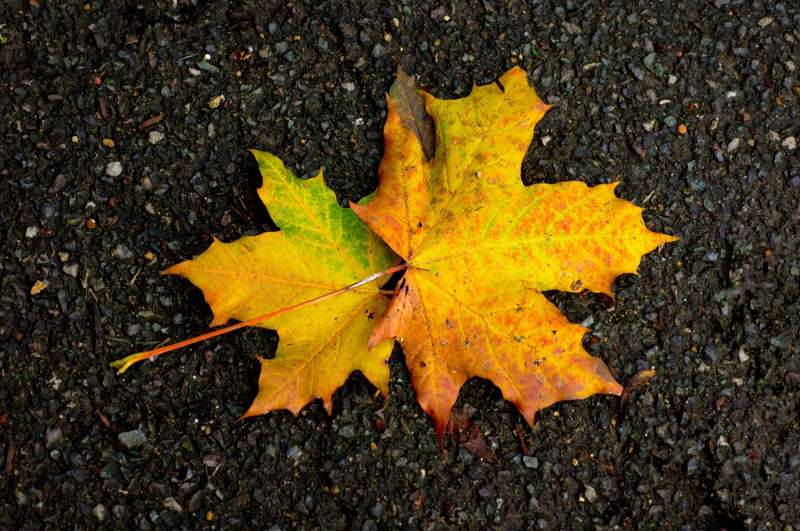
Two leaves, shot with a
Nikon D2Hs, 80-200mm f/2.8 AF-D at
129mm and f/6, 1/160 at ISO 200.
Autofocus speed is dependent on your camera; it's driven by a mechanical linkage between your camera and your lens. It's very fast on the D1, D2Hs, D200 and F5, and somewhat slower on a D70 and an F55.
Just as the autofocus speed depends on your camera, so does the amount of noise it makes. The 80-200mm makes very close to exactly the same noise as a 50mm f/1.8D does on whatever camera I put it on, which means that the lens itself is making very little noise.
On a fast-focusing camera, you can feel the torque of the autofocus mechanism through the lens barrel! I actually like this; it makes it easy to tell by feel if the autofocus is hunting, which is a whole lot better for moving subjects than keeping your eye in the bottom left corner of your finder to see the autofocus confirmation dot.
The 80-200mm is a superb lens, at least on the DX cameras I use. I don't shoot test charts to find defects in lenses that serve me very, very well in the real, non-test-chart world, so there it is; you'll probably find worse things than I did if you go out looking for flaws. As for me, I'll shoot at whatever aperture I need to get the shot I want; this lens is always going to be very sharp.
The only annoying defect I have found in actual use is spherochromatism affecting things that are very slightly out of focus, which is a phenomenon seen more easily at the lens's widest aperture. I'm a full-time cat photographer, so you'll see it here as purple fringes around Lily's whiskers in this shot:

Remember: I had my autofocus point on her closest eye so her whiskers were just a hair (RIMSHOT) out of focus. Lily paid me a lot of money to be her official photographer and when I come back with this shot she noticed the spherochromatism right away, got very angry and I nearly lost the job to a guy with a 55-200mm VR. (She got over it; she was just cranky because I forgot to feed her that morning.)
On the upside, the 80-200mm focuses very, very close at all focal lengths. It has a reproduction ratio of 1:5.9, which means it'll fill a full 35mm frame with a subject 21cm wide at 200mm.
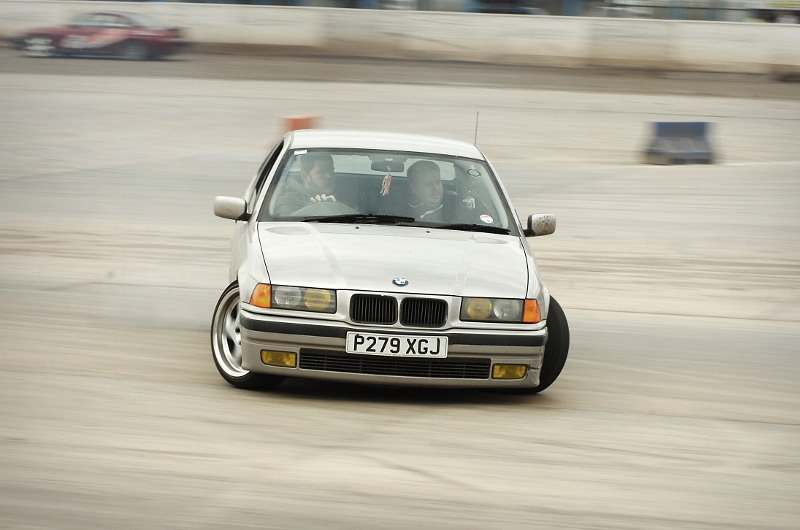
Josh Milwain, shot with a
Nikon D2Hs, 80-200mm f/2.8 AF-D at
80mm and f/11, 1/100 at ISO 200.
The 80-200mm is a very well-built lens, and it's as tough as autofocus lenses get at any price. Just about everything other than the aperture ring, the auto/manual focus switch ring and the focus limiter switch is made of metal.
It's a lovely thing to feel and admire when you're not in the field, but this also means it's a very heavy lens! It's a pain to carry around all day. On a lighter camera without a vertical grip the lens tends to point downwards, which is comfortable. On a D2Hs or any camera with a battery grip it's awkward because it finds a natural balancing point of the edge of your battery grip, which means that all of its weight rests on a very thin area.
This isn't a defect with the lens. It's what you get for owning a professional f/2.8 telephoto zoom.
Always attach tripods onto the tripod collar of the lens, not onto the camera. Wimpier plastic cameras like the F55 are likely to break if you hang the weight of this beast on them.
The only problem with mine is that occasionally, as in once-in-five-hundred-shots occasionally, at 8 frames a second on my D2Hs, the aperture sometimes does not stop down quickly enough and the result is gross overexposure. No lens I've owned has done this; it's likely that mine just needs a good service.
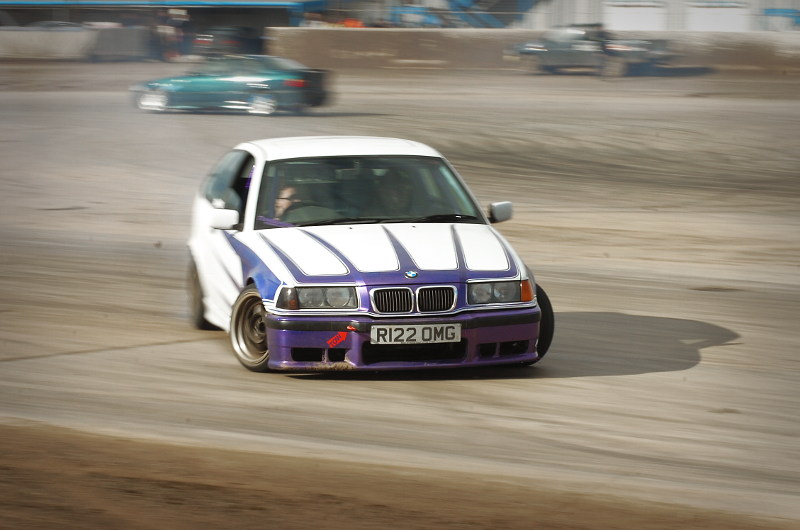
Josh Phillips, shot with a
Nikon D2Hs, 80-200mm f/2.8 AF-D at
80mm and f/16, 1/100 at ISO 200.
If you need a fast-focusing f/2.8 telephoto lens built to professional standards, then the 80-200mm f/2.8 is unbeatable at the price (about £500 used, or less than £700 new).
I bought mine for shooting drift racing, and then didn't use it nearly as much as I thought I would. Mostly, it's because the 80-200mm is so big and heavy that I hate carrying it all day. And nearly all of my best shots were taken by getting closer and shooting with my 18-70mm DX between 35mm and 70mm.
I skipped the earlier 80-200mm f/2.8 lenses. From what I read, they autofocus too slowly for fast-moving subjects, and I'm not sure you'd want one of these f/2.8 telephoto lenses for anything other than shooting things on the move when a 55-200mm VR would work just as well.
On the upside, the older 80-200mm lenses are cheap, so if you don't need fast autofocus then they are optically the same for half the price. If Canon DSLR videographers, who don't need or use autofocus, haven't figured it out already: one of these older lenses, plus a simple F-mount-to-EOS adapter, will cost you about half of a used 80-200mm or 70-200mm f/2.8 EF lens!
For shooting still subjects with a DX camera, the plastic 55-200mm VR is optically about as good as this professional lens, for about a fifth of the price new as this sells for used, with about a quarter of the weight. For stills, the glacial autofocus of the 55-200mm VR isn't an issue. Yes, it's two stops slower at the telephoto end, and this doesn't matter because the 55-200mm's VR system more than makes up for it for hand-held still shooting. If you're shooting from a tripod, then the non-VR 55-200mm works just as well as that, for even less money, if you can find one.
If you want VR and fast autofocus, then you either need to get the cheaper 70-300mm VR, which is f/5.6 on the long end, or the vastly more expensive 70-200mm f/2.8 VR. At twice the price, meh; the 80-200mm focuses fast enough for me and the 80-200mm forced me to improve my hand-held technique by about a stop, which gave me about half the benefit of VR for free.
Thanks to the Norfolk Arena Drift Team for their monthly, free-to-spectate events.